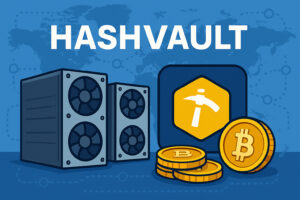Introduction
HashVault is a cryptocurrency mining pool that enables the aggregation of computing power to be used to efficiently mine a multitude of different coins. Released to make it easy for the miners of projects like Ergo and other proof-of-work chains, HashVault simplifies contributing hash power. If you’ve wondered how solo miners collaborate to discover blocks more quickly, HashVault is the answer. In the following article, we will examine what sets HashVault apart, its technical underpinnings, and how it benefits the mining community.

Mining rigs and pool symbol set against a global network backdrop.
Overview of HashVault
HashVault is a cooperative system in which individuals connect their rigs to pooled servers. Through a shared resource, participants maximize the possibility of finding a block and receiving a reward. Instead of pursuing isolated, long-shot wins, users are provided with regular returns that correspond to their share of the labor.
The dashboard for the pool also includes live hashrate, anticipated rewards, and server health. You can keep an eye on your rig’s performance via a basic web console rather than having to toggle between multiple command-line tools. HashVault also includes email and Telegram notifications, so you will be notified when a miner is down or a block is discovered.
HashVault initially operated with support for the Ergo blockchain, adding support for other proof-of-work-based coins very soon. HashVault’s aim is to maintain low fees and a transparent policy so that the pool can be trusted by the miners when they increase their hardware investment.
Pool Architecture and Network
In its simplest form, HashVault uses a network of stratum servers that send out jobs to the connected rigs. Stratum is a protocol which fragments the work into tiny slices, so the miners can return “shares” of their labor back to the pool. A share is proof that your machinery did a particular amount of work.
HashVault operates multiple server sites worldwide, including North America, Europe, and Asia. With this international distribution, your miner can be matched up with a server that’s closer to you, eliminating latency and increasing efficiency. With lower latency, your rig spends less time idle waiting for new jobs and more actual crunching of hashes.
Behind the scenes, HashVault’s infrastructure supports an array of failover mechanisms and load balancers. When one server goes out, the miners will automatically fail over to a backup without losing many shares. The architecture minimizes downtime and ensures a constant supply of work for your ASIC or your GPU hardware.
Supported Coins and Algorithms
Whereas HashVault began with Ergo’s Autolykos algorithm, it also now supports a number of others. There are options for such coins as RavenCoin (KawPow), Conflux (Octopus), and Beam (BeamHash), to name a few. Each algorithm’s mining software and configuration is different, though HashVault’s manuals help make the process easier across the categories.
For instance, if you are mining with an AMD graphics card using Autolykos, then you can utilize NBMiner or lolMiner. For Nvidia rigs with KawPow, you can use T-Rex or TeamRedMiner. HashVault offers you sample command lines that you can simply copy and paste, rather than having to find each parameter yourself.
Integrating new coins is a community-based process. HashVault’s developers keep an eye out for growing small projects and welcome community requests. It means if a new proof-of-work chain becomes popular, the miners can request the HashVault team to review integration. The approach is dynamic, keeping the pool up to date with the changing trend.
Payout System and Fee Structure
HashVault employs a pay-per-share version known as PPLNS (Pay Per Last N Shares). As opposed to paying per share, the reward is calculated from the last number of shares when a block is discovered. It compensates constant network participants who are plugged in for the long term, averaging out the block finding randomness.
The default charge for most of the coins on HashVault is 1 percent, which is in line with most pools. The fees fund server expenses, development, and community endeavors like bounties for open-source contributions. The transparency of the fees shown on the website is something that the miners like so that there are no surprises.
Automatic payments are made when you hit a configurable level—usually a percentage of a coin. You can change the level to your liking. When you dig up a low-denomination coin, you can reduce the level to receive payments frequently. For a more expensive coin, a higher level lowers network charges for transactions.
Monitoring Tools and the User Dashboard
HashVault’s dashboard for users is architected to provide miners with all the information that matters at a glance. It shows your overall contributed hashrate, unpaid balance, and your most recent payment history. You can drill down further and get the statistics of a single rig by inputting your wallet address.
Mobile alert enthusiasts will appreciate HashVault’s Telegram and email integrations. You can be notified when your rig goes offline or when you receive a payment. Getting such prompt feedback in the form of alerts ensures you identify hardware failures early and do not go for long stretches without earning.
Advanced users can access HashVault’s API to programmatically fetch the data. To implement custom notifications or feed your monitoring application, the API points return JSON with information regarding shares, blocks, and payments. The flexibility this offers you enables you to integrate the pool’s data in your customized workflow.
Community Engagement and Support
HashVault is currently active across Discord, Telegram, and GitHub. If you encounter problems configuring your miner or you’ve identified a bug, you’re likely to receive a prompt resolution from the community. The developers of the pool also make announcements regarding upcoming updates and maintenance.
Contributions are welcome in open-source. HashVault’s GitHub repository contains stratum server code, web UI scripts, and configuration samples. You can fork the pool’s code to test locally or submit improvements through a pull request. The open, transparent model encourages shared ownership over a closed, corporate model.
Recurring “Ask Me Anything” events on Discord provide an opportunity for the HashVault team to directly hear the concerns of the miners. Live discussions include such subjects as future algorithm support, fees, and performance tuning. The conversation keeps the pool attuned to what the miners need.
Security and Reliability
Security is a priority for every mining pool, and HashVault uses a number of protections for securing the miners and infrastructure. All web traffic is carried over HTTPS, keeping your dashboard login and API requests confidential. The Stratum connections can even be encrypted so shares cannot be intercepted by the wrong parties.
Server nodes are based on hardy Linux distributions, with firewall controls that confine access and narrow down attack surfaces. System configurations and logs are backed up regularly so that even if a server fails, the team can recover quickly. Redundancy protects both the data of users and the pool’s continuity.
Last but not least, HashVault offers publicly displayed uptime statistics. If you want to understand the pool’s availability, you can look at charts illustrating downtime, block-finding times, and server loads. Transparency creates trust because miners can personally verify the service level instead of simply taking the operator’s word for it.
Conclusion
However, HashVault presents miners with an obvious route to share pooled rewards with a simple interface, worldwide servers, and support for multiple proof-of-work-based coins. With a combination of low fees and open-source operations with community-led development, it caters to both professionals and hobbyists.
Whether you are looking to optimize the settings for a single GPU or establish a large ASIC farm, HashVault provides the tools and the feedback you require. Pool entry translates to unlocking aggregated power and robust infrastructure—factors crucial for stable mining revenue.












 Twitter
Twitter
 Telegram
Telegram
